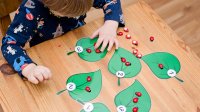Building Early Confidence in Math
It’s important that students in preschool through third grade believe in their growing mathematical capabilities.
Your content has been saved!
Go to My Saved Content.Raise your hand if you’ve heard or said the phrase “I am terrible at math.” (OK, hands down.) I’m sure that if I could see all of you, there would be a sea of hands in the air. How is it possible that so many people have reduced a subject encompassing so many activities and perspectives and come to the conclusion that they are “bad” at it… all of it? And yet, this is the situation we have—people generally align themselves with either Team: Good at Math or Team: Bad at Math.
When I became a teacher of young children, I never wanted my students to feel incapable or fearful of any subject. As much as possible, I wanted my words and classroom visuals to act as mirrors and windows, in the metaphor popularized by Rudine Sims Bishop, for students to see that their work had value and meaning in the classroom and in the world.
Two ways to help students feel affirmed in their mathematical endeavors are posting portraits of the students engaged in math activities, and reading math-themed books to students that feature children who are engaged in personally meaningful math activities.
‘Math Is Everywhere’ Student Portrait Display
A teacher who photographs a child at work sends the message, “You are seen, and your work has value and meaning here.” Seek out moments that capture the often-elusive yet fully awe-inspiring math moments that children create and are instantly gone at the end of a lesson:
- Designate wall space for a “Math Is Everywhere” display.
- Encourage math moments to photograph by providing inspiring STEM materials—for example, math manipulatives (e.g., Unifix Cubes, wooden cubes, and pattern blocks); collections (e.g., shells, buttons, and keys); construction toys (e.g., Magna-Tiles, Lego Duplo, and unit blocks); or craft materials (e.g., beads, craft sticks, and pipe cleaners).
- Take a portrait of each student engaged in a math investigation.
- Print out each portrait, ideally 8.5 by 11 inches.
- Label each photo with the student’s name, the date, and a student dictation of the math connection depicted in the photograph.
- Post new portraits each month.
- Encourage classroom math discussions about the portraits.
- Include these portraits in each student’s portfolio.
Math-Themed Picture Books
A second way for students to identify what math looks like is by reading picture books about math. The benefit of the following eight math picture books is that these are foundational books that affirm that there are many ways to see math in the world.
Each of these picture books proposes a mathematical journey for young children and offers the possibility for fuller classroom discussions with a math and literacy connection.
Five Creatures, by Emily Jenkins, illustrated by Tomek Bogacki. Five creatures live in a house: two adult humans, two adult cats, and one child. The little girl sorts her family throughout the day, categorizing each member via different attributes (e.g., “Three short and two tall”). (Preschool–kindergarten)
I Know Numbers!, by Taro Gomi. The first sentence proclaims, “Numbers are everywhere!” Gomi then takes us on a tour through a home and community to showcase all of the places and ways that numbers help people navigate their world. (Preschool–kindergarten)
One Boy Watching, by Grant Snider. A little boy on the school bus counts objects on his rural journey to and from school. Snider shares the backstory to writing his book. (Preschool–kindergarten)
Count on Me, by Miguel Tanco. A little girl navigates and documents each day with a vision and passion for all things math. Her math journal is featured at the end of the book. You can watch author/illustrator Tanco read his book. (Preschool–grade 2)
We Are One: How the World Adds Up, by Susan Hood, illustrated by Linda Yan. The star of this book is an enthusiastic and whimsical cosmic tour guide. This book emphasizes number standards for groups of people, objects, and systems. (Preschool–grade 2)
Leo + Lea, by Monica Wesolowska, illustrated by Kenard Pak. Leo counts objects in his world applying the Fibonacci sequence. Lea is a new girl in Leo’s class who loves drawing as much as Leo loves counting. Soon the duo find something that they have in common: They both love patterns! You can watch Wesolowska and Pak introduce their book. (Preschool–grade 3)
Uma Wimple Charts Her House, by Reif Larsen and Ben Gibson. Uma has been a cartographer since age 4. Years later, a school assignment makes her chart-making dream come true. What was so easy in the past, however, becomes her biggest challenge to date: Make a chart of your home. You can watch Larsen read this book. (Preschool–grade 3)
Zero Is the Leaves on the Tree, by Betsy Franco, illustrated by Shino Arihara. This book follows a group of children throughout the year as they identify examples of zero. Zero is poetically explained as the absence of something. (Kindergarten–grade 2)
